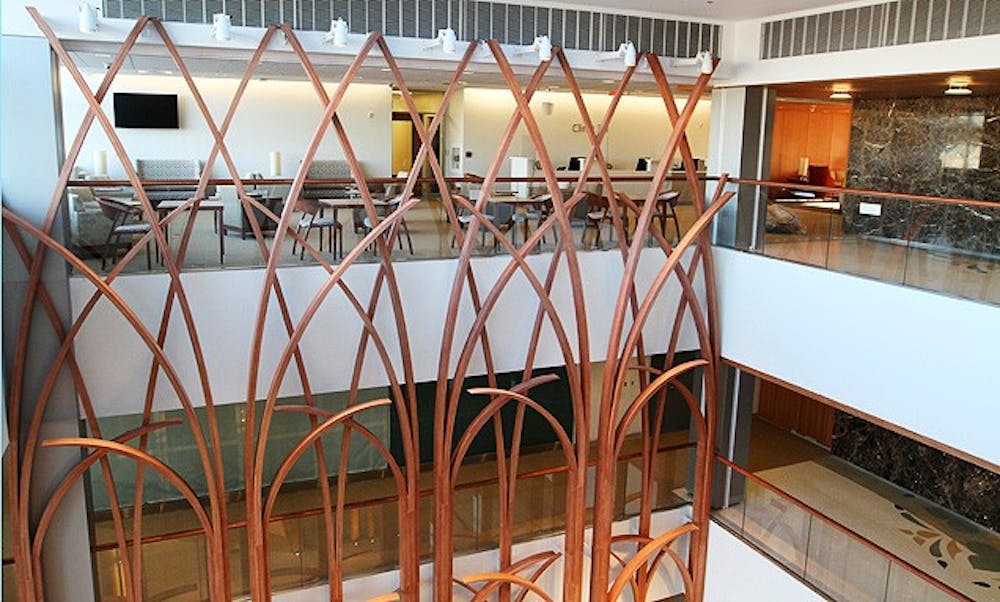Duke will debut an integrated model for cancer treatment when the Duke Cancer Center opens its doors this month.
In 2005, Duke Medicine launched a strategic plan that identified the need for a new cancer facility to manage a growing number of oncology patients. The remedy will finally come to fruition in the new Duke Cancer Center, a facility that weaves together innovative research and cancer treatment in a holistic and centralized patient experience. The center will have an open house Feb. 22, and it will open to patients Feb. 27.
Designed to optimize patient care by placing all outpatient oncology services under one roof, the $230-million center will promote multidisciplinary communication through the Duke Cancer Institute’s mission of integrated cancer treatment and clinical research. Duke Cancer Institute’s support services will also move into the new building to offer emotional support to patients going through treatment.
“Our concept is to create an institute to bring everyone around the patients for the best care,” said Dr. Victor Dzau, chancellor for health affairs and president and CEO of the Duke University Health System. “Patients can feel at home and feel welcome without having to go from one place to another.”
The center is also designed to provide a warmer and more welcoming environment for patients and their families, Dzau said. Certain amenities, such as a quiet room and garden, will provide outlets for stress and fatigue.
“When you think about treating patients you are treating the whole patient—mind and body,” he said. “It’s about personal care not just clinical care.”
The garden is connected to the infusion room, to provide natural light to patients receiving chemotherapy treatment. The relaxation room offers a quiet respite from the building, in a circular room with ambient lighting and sound controls. The ground floor also includes a cafe and boutique for specialized items like turbans, wigs, scarves and prosthetics for cancer patients. Additionally, patients will receive restaurant-like pagers to let them know when their doctors are ready to meet them, allowing the patients freedom to move through the building in the mean time, said Associate Chief Nursing Officer Tracy Gosselin, who contributed to the planning of the center.
Departments in the center include radiation oncology, breast and gynecology oncology clinics, brain tumor and melanoma clinics and others. Gosselin, also the director for oncology services at Duke University Hospital, noted that this centralization of services will improve the flow of patient services, compared to the current geographically disjointed system.
“There is a very non-centralized feel right now for people who have to go throughout the cancer experience, from lab to radiology to where the clinics are,” Gosselin said. “We’re really trying to provide the core set of services within the building.”
Cancer patient groups formed under the Patient Advocacy Council—an independent, institutional review board that advises clinical research—gave input on what they would like to see in the building during the initial phases of planning, said Carolyn Carpenter, associate dean and administrator of the Duke Cancer Institute, which jump started the mission of translating research into advanced cancer care. Their recommendations resulted in the addition of five attributes—natural light, privacy, rejuvenation centers, a building designed on a humanistic scale and the ability for patients to communicate with each other during infusion treatments, if desired.
“Other hospitals have overly big cancer centers that it make you feel like you’re going into an arena, which is very dehumanizing to people,” said Carpenter, who is also the associate vice president for oncology services in the health system. “We worked hard to avoid that type of space by... making sure people do not feel like they are part of a warehouse or machine.”
Located next to the Morris Cancer Clinic, the seven-story, 267,000 sq.-foot Cancer Center will feature 123 clinical exam rooms, 73 infusion stations and three clinical floors. Additionally, an enclosed air-conditioned concourse will connect the Cancer Center facility to the Duke Clinics, as well as to the currently under construction Duke Medicine Pavilion and Duke Hospital. The center is part of DUHS’s roughly $700-million expansion and is paid for through a combination of funds borrowed, rasied and in reserve.
Staff members have begun training and orientation for the move into the new building, said Tina Piccirilli, director of the Duke Center for Cancer Survivorship.
“When you look at a building for a long time on paper it’s just a concept,” Piccirilli said. “Now that people can actually see it… they are more excited about the building.”
Dr. Nancy Andrews, vice chancellor for academic affairs and dean of the School of Medicine, noted that the new Cancer Center could attract faculty recruits, fellows seeking training in cancer-related areas and patients. The main benefit the new center will provide is a place to make cancer care focused on the needs of the patient.
“People go through a lot when they have cancer,” Andrews said. “We tried to make it so their experience is as comfortable, streamlined and focused as possible.”
Julian Spector contributed reporting.
Get The Chronicle straight to your inbox
Signup for our weekly newsletter. Cancel at any time.

